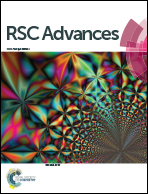An efficient and cyclic hydrogen evolution reaction mechanism on [Ni(PH2NH2)2]2+ catalysts: a theoretical and multiscale simulation study†
Abstract
In this paper we report a theoretical and a multiscale simulation study of the hydrogen evolution reaction (HER) on the [Ni(PH2NH2)2]2+ catalyst in acidic media (2H+ + 2e− → H2). First, at the DFT calculations level, a cyclic pathway for the HER is proposed highlighting the shuttling of electrons with protons on the conformationally flexible catalyst. The theoretical calculation gives a better understanding of the efficient cyclic pathway of [Ni(PH2NH2)2]2+, and the effect of solvent on the mechanism has been discussed. The σ-donating and π-accepting nature of H2–Ni bond has been identified in the H2 complex. The oxidation state of the Ni centre and geometrical changes of the catalyst in the reaction coordinate are also identified. Then a mean-field kinetic model incorporating the calculated DFT data has been developed. This model allows us to simulate the behaviour of these catalysts in electrochemical conditions representative of polymer electrolyte membrane water electrolyzers operation. Calculated results include experimental observables such as polarization curves showing good agreement with available experimental data. Competitive phenomena between the different electrochemical mechanisms, the protons and H2 transport, and their relative impact on the overall cell performance are particularly discussed.
![Graphical abstract: An efficient and cyclic hydrogen evolution reaction mechanism on [Ni(PH2NH2)2]2+ catalysts: a theoretical and multiscale simulation study](/en/Image/Get?imageInfo.ImageType=GA&imageInfo.ImageIdentifier.ManuscriptID=C3RA44896G&imageInfo.ImageIdentifier.Year=2014)

 Please wait while we load your content...
Please wait while we load your content...